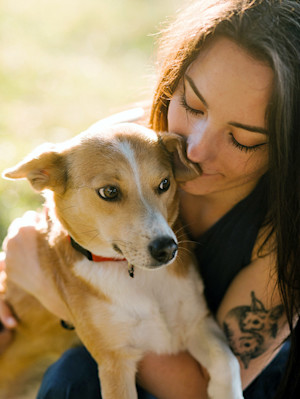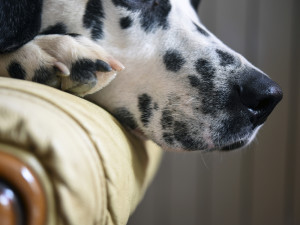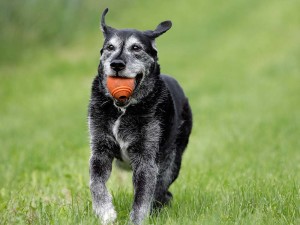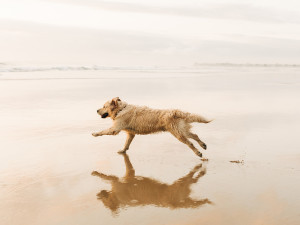Why Is My Dog Limping? Common Causes And How to Care For Them
And when to seek veterinary help to keep your pup healthy and happy.
In This Article:
Common Causes of Limping In Dogs Identifying Injuries: Minor vs. Serious Immediate Care For a Limping Dog When to Call The Vet For Limping In Dogs Preventing Limping: Tips For Dog Parents
As humans, we’re no strangers to a little leg pain that could cause us to limp from time to time. Considering that dogs have twice as many legs as us, it should come as no surprise that limping is a common issue that veterinarians see on nearly a daily basis.
A dog’s lameness can be mild and take care of itself, or it can be severe enough to affect more than just a dog’s mobility. Either way, you’ll want to get to the bottom of your dog’s limping so that you can best provide supportive care. We’re here to help.
Save on the litter with color-changing tech that helps you better care for your cat.
Common causes of limping in dogs
The first step in getting back your dog’s smooth mobility is to find out what’s behind their limp. It may be something obvious, such as a sore on their paw, or something that your vet has to investigate, such as arthritis.
Injuries
The legs have a lot of working parts, which makes for a lot of potential things that can get injured, especially when you add in some dog’s hyperactive personalities. Muscles, bones, tendons, ligaments, and skin are all up for grabs in the injury department, with some being more serious than others.
Common injuries include:
Cranial cruciate ligament tear
Bone fracture
Muscle, tendon, ligament strain, or sprain
Muscle bruise
Laceration
Joint dislocation
Insect bite or sting
Health conditions
Whether it’s a whole-body condition, such as a tick-borne disease, or a leg-centric issue, such as hip dysplasia, a number of different health conditions can cause lameness in dogs. Potential health conditions that your vet will be on the lookout for include:
Panosteitis
Intervertebral disc disease
Elbow and hip dysplasia
Lyme’s disease
Infections
Cancer
Luxating patella
Vascular or nerve issues
Foreign objects
Though you’re probably more familiar with a dog ingesting a foreign object, another common cause of limping in dogs is when one gets embedded in their paws. Grass seeds, thorns, or thistle stickers are likely culprits to pierce the skin between a dog’s toes, causing pain, swelling, and potentially an abscess that can have your dog limping and obsessively licking their feet.
Identifying injuries: minor vs. serious
Let’s focus our attention on one of the major causes of limping in dogs: injuries. Again, an injury to any of the parts of a leg can lead to limping, some of which will get better on their own and some of which will require veterinary input. Here are some ways to tell the difference.
Minor injuries
For most bumps, bruises, and minor strains, a dog’s limp may be fairly mild. They will typically bear some weight on the leg and will often still want to go for a walk or have some playtime. You may see an area of swelling or find a small wound. If left alone or given a few days of rest, most minor injuries will resolve on their own.
Serious injuries
If you see a more noticeable limp, or your dog is carrying their leg completely, the injury is likely serious. They probably won’t be excited about their daily walk and instead prefer to stay in the comfort of their bed. If the pain is severe, your pup may even pass up dinner.
There may be a more significant wound on their paw or leg or you may find larger areas of swelling. Sometimes you won’t find anything at all, which can be frustrating.
Severe injuries likely won’t get better on their own and may even get worse if you don’t get your veterinarian involved.
Immediate care for a limping dog
Limping is typically a sign of pain, so it’s best not to force your dog to walk. Instead, start here:
Inspect the paw and leg. Look for wounds, swelling, redness, or any other abnormalities that might clue you into the cause of your dog’s limping.
Rest and restrict movement. You don’t want to make things worse, so allow your pup to rest and consider confining them to a small space to keep movement to a minimum. This will allow minor issues to heal without causing extra irritation.
Apply a compress. If your pup allows it, alternate cold and warm compresses at the site of the injury. Always have a barrier between your dog’s skin and the compress and leave each one on for about 10 minutes. Some dogs will really lean into this, and some won’t. You’ll just have to work with your pup the best you can.
When to call the vet for limping in dogs
Since some mild limping in dogs will resolve on its own, you’ll need to make a decision about your dog’s level of discomfort. If they seem alright other than a slight limp, you may choose to allow them a little rest and watch them for a few days. However, if their limp is more severe or it’s causing issues with other things such as appetite, consult your veterinarian right away.
Visible signs
If you see a noticeable abnormality, such as a more serious wound or area of swelling, see your vet rather than wait, especially if your dog won’t bear weight on the leg.
Recent injury
Witnessing your dog’s injury can be traumatic for both of you, but it may help determine the severity of the issue. Hearing a popping sound or knowing that your dog landed oddly on their leg are good nuggets of information to share with your veterinarian.
Duration of limping
Severe limping is a definite reason to see your vet, but so is minor limping that lasts longer than a couple of days, especially if that limping is getting worse.
Treatment for Limping
Your vet will treat your dog’s limping based on the cause. Treatment may range from anti-inflammatory and pain medications to surgery to repair a fractured bone. Dogs may also benefit from treatments such as acupuncture and physical therapy.
Preventing limping: tips for dog parents
Covering your dog in bubble wrap isn’t an option, so you won’t be able to prevent all causes of limping in dogs, but you can decrease the likelihood by taking a few precautions.
Regular exercise
The stronger your dog’s muscles are, the better equipped they are to prevent an injury. Regular exercise not only helps strengthen muscles but also helps keep joints flexible and bones strong. Great options for low-impact exercise include swimming, walking, and hiking. You’ll want to avoid high-impact workouts, especially those that include jumping and twisting, for puppies and senior dogs.
Maintain a healthy weight
Excess weight equals excess pressure on a dog’s joints which equals increased wear and tear over time. Being overweight also increases a dog’s chances of serious injuries, such as tearing a tendon or a ligament. You can help your dog maintain a healthy weight by feeding them the right amount of good-quality dog food, giving them regular exercise, and avoiding high-calorie treats, such as human food.
Paw care
A dog’s paws are really where the rubber meets the road. They literally come in contact with everything your dog encounters in a day, so they deserve a little special care. Consider covering your dog’s paws with booties when it’s overly hot or cold outside or when you’re taking them on an especially rough trail. Inspect their paws when they come inside for any cuts or scrapes, and keep the pads from cracking by applying a paw moisturizer when needed.
References
Madson, Cathy, MA, FDM, CBCC-KA, CPDT-KA. “How Much Exercise Does Your Dog Need?” Preventative Vet. May 2025. https://www.preventivevet.com/dogs/how-much-exercise-dogs-needopens in new tab.
“Observational Study on Lameness Recovery in 10 Dogs Affected by Iliopsoas Injury and Submitted to a Physiotherapeutic Approach.” Animals. 6 Feb 2021. https://pmc.ncbi.nlm.nih.gov/articles/PMC7914594/opens in new tab.
Scharvogel, Stefan. “Beyond the limp: the art and science of diagnosing and treating canine lameness.” AO Vet. 3 Dec 2024. https://www.aofoundation.org/vet/about-aovet/blog/2024_12_blog_scharvogel_lameness-in-dogsopens in new tab.










